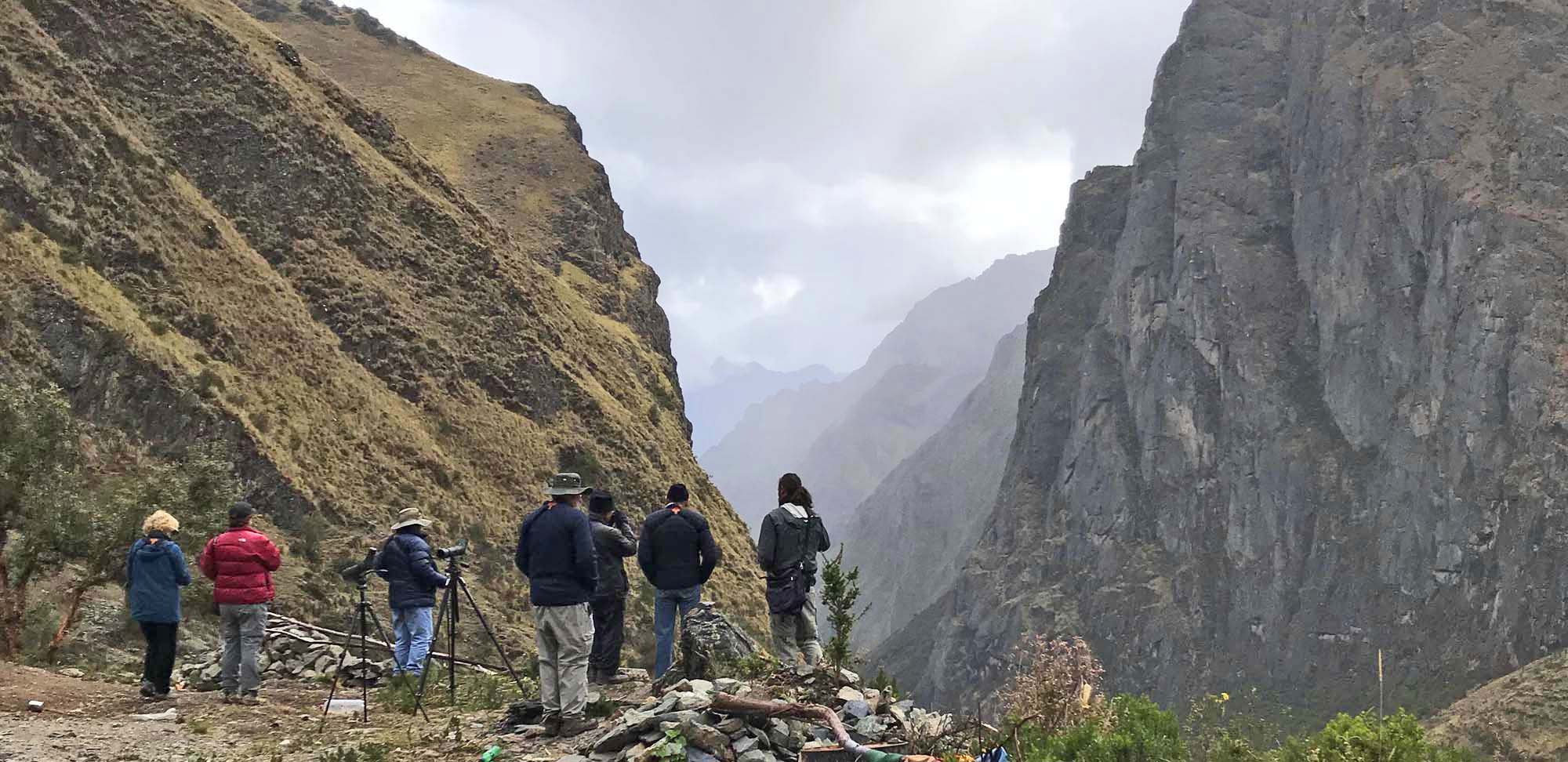Perched imposingly atop a high ridge surrounded by rugged, forested mountains, the ruins at Machu Picchu tower above the rushing waters of the Rio Urubamba snaking its way fifteen-hundred feet below. Without a doubt, Machu Picchu is one of the most spectacular archaeological sites in the world. It would be fair to say that this architectural masterpiece is on most everyone's short list of silent cultural attractions South America holds--and with good reason. Perched imposingly atop a high ridge surrounded by rugged, forested mountains, the pre-colonial Inca ruins tower above the rushing waters of the Rio Urubamba snaking its way a thousand feet below. The conception and the sheer craftsmanship are remarkable by any standards. By staying two nights--and two mornings--in the Machu Picchu area (near the town of Aguas Calientes), we can enjoy a more relaxed pace during our visit.
As if the ruins alone were not worth the visit, the subtropical slopes and the narrow gorge below are surprisingly good for birding. On the grounds (averaging about 6500 feet) of our lovely hotel we may see such knockouts as Andean Cock-of-the-rock, Andean Motmot, Masked Fruiteater (a Peruvian endemic), Inga trees and plentiful feeders full of hummingbirds--including the endemic Green-and-white, the colorful Collared (Gould's) Inca, and the fawn-booted Booted Racket-tail--numerous vivid tanagers (including the scarce Silvery), White-eared Solitaire, White-throated Quail-Dove, Ocellated Piculet, and Speckle-faced (Plum-crowned) Parrot. The bamboo around Machu Picchu itself is, fittingly, one of the best places to see the endemic Inca Wren, and a morning's birding along the tracks below the hotel usually results in a pleasing variety of species, often punctuated by an Andean Guan, a Fasciated Tiger-Heron, a Black-streaked Puffbird, Slaty Tanager, or perhaps a group of Oleaginous Hemispingus, Dusky-green Oropendolas, or Mitred Parakeets (but usually not all together!). Situated at about 8500 feet, the archaeological site is considerably lower in elevation than the Malaga area, yet our visit to "the heights of Machu Picchu" will in many ways be the high point of a very lofty tour.
After visiting Machu Picchu, our birding tour will be off on a temperate adventure to the fertile Sacred Valley of the Urubamba and the glorious Cordillera Vilcanota. We'll take the afternoon train back to Ollantaytambo, where we'll disembark for our nearby lodge, our base for three nights as we make early departures for the high pass along the road that crosses the Andes on its way to Quillabamba in the lower Urubamba valley, closer to the Amazonian lowlands. This extraordinarily scenic road affords us access to a cross section of habitats and to some of the best high Andean birding in all Peru. Abra Malaga, at 14,200 feet, is the low point, or pass, along a ridge of rugged peaks called the Vilcanota Mountains separating elfin tree line and humid temperate forest on the northwest from the dry, shrub-covered slopes of the upper Rio Urubamba Valley. Buffering the upper limits of these habitats is the starkly beautiful puna grassland dotted with llamas, alpacas, and the very occasional cluster of stone houses, corrals, and fences erected by Quechua-speaking families who are somehow accustomed to prospering in what seems to most visitors an inhospitable environment.
The bird life to be found in these habitats includes many species endemic to a small geographic area in southern Peru and many species limited to southern Peru and nearby Bolivia. Peruvian endemics we're likely to see include the fancy Bearded Mountaineer, White-tufted Sunbeam, Junin and Rusty-fronted canasteros, White-browed Tit-Spinetail, Marcapata and Creamy-crested spinetails, Unstreaked Tit-Tyrant, Parodi's Hemispingus, and Chestnut-breasted Mountain-Finch. Even Royal Cinclodes is a very distant possibility. But this wonderful tour, which we have operated many times yet anticipate with excitement each year, is also distinguished by a wealth of birds that aren't strictly endemics but are seldom seen elsewhere, prizes such as Black-faced (Andean) Ibis, Line-fronted Canastero (a particularly beautiful Asthenes if we do say so!), Stripe-headed Antpitta (one of the few antpittas easily seen once found), the well-marked Diademed Tapaculo, Puna Tapaculo, Ash-breasted Tit-Tyrant, Three-striped Hemispingus, and the exquisite Golden-collared Tanager. After birding for three full days at Abra Malaga, we'll bus back to our hotel in Cusco for an overnight stay before heading back to Lima.
Join us for this fabulous birding adventure in Peru! You can find additional information including a day-by-day itinerary and past trip reports by clicking on the "Key Info" and "Triplists" tabs above.
Select the KEY INFO tab or click here for our itinerary plus space requests, status, fees, limits, and guides for any departure.
Client comment
"The experience was better than I could ever have imagined! The best features were Machu Picchu, of course, and birding in the mountains--the scenery was spectacular... The group was great--really compatible, and fun to be with. Guide Dan Lane was both knowledgeable and very personable." M.I., MACHU PICCHU & ABRA MALAGA, PERU
Combo Tours
If you would like a longer birding holiday, some departures of this tour may be combined with:
PERU'S MAGNETIC NORTH: Spatuletails, Owlet Lodge & More
GALAPAGOS: An Intimate Look at Darwin's Islands


